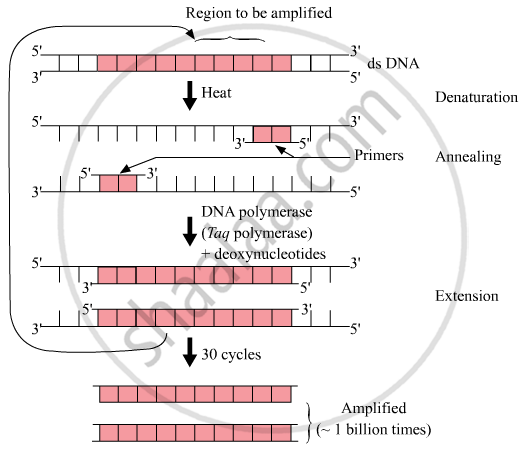Advertisements
Advertisements
प्रश्न
Many copies of a specific gene of interest are required to study the detailed sequencing of bases in it. Name and explain the process that can help in developing large number of copies of this gene of interest.
उत्तर
Polymerase chain reaction (PCR) is used for developing multiple copies of DNA containing the gene of interest.
In this process, two sets of primers (chemically synthesised oligonucleotide stretches that are complementary to a region of DNA), enzyme DNA polymerase and deoxynucleotides are added.
PCR consists of three steps:
- Denaturation: It occurs at 94°C in which double helical DNA is denatured and opens into the two pieces of ssDNA. DNA polymerase does not get degraded in such high temperatures, as it is isolated from thermophilic bacteria, Thermus aquaticus (Taq) and is thermostable.
- Annealing: It occurs at 50-65° C for some seconds to allow annealing of primers to single stranded DNA templates. DNA polymerase extends the primer in 5' to 3' direction.
- Extension: It occurs at 72°C in which replication of DNA occurs in vitro.
This cycle is repeated several times to generate up to 1 billion identical copies of the DNA.
APPEARS IN
संबंधित प्रश्न
Answer the following question.
Explain the mechanism of DNA replication with the help of a replication fork. What role does the enzyme ONA-ligase play in a DNA replication fork?
Multiple Choice Question:
Griffith worked on ____________.
Identify the observations that were made in Hershey-Chase's experiment, when the radioactive viruses were allowed to infect E. coli.
P. E. coli which were infected by viruses with radioactive DNA became radioactive.
Q. E. coli which were infected by viruses with radioactive protein did not become radioactive.
R. E. coli which were infected by viruses with radioactive protein became radioactive.
S. E. coli which were infected by viruses with radioactive DNA did not become radioactive.
Study the following statements and select the correct option.
- 'R' strain of S. pneumoniae is nonvirulent, rough, non-pathogenic, and non-capsulated.
- 'S' strain of S pneumoniae is virulent, smooth, pathogenic, and encapsulated.
A bacterium grown over medium having radioactive 35S incorporates radioactivity in ______.
The experiments by Hershey and Chase helped confirm that DNA was the hereditary material on the basis of the finding that ______.
Give an account of Hershey and Chase experiment. What did it conclusively prove? If both DNA and proteins contained phosphorus and sulphur do you think the result would have been the same?
What will happen if the double-stranded RNA is produced during transcription?
Describe Griffith's transformation experiment.
Out of 64 codons only 61 code for the 20 different amino acids. This is known as ______ of genetic code.
